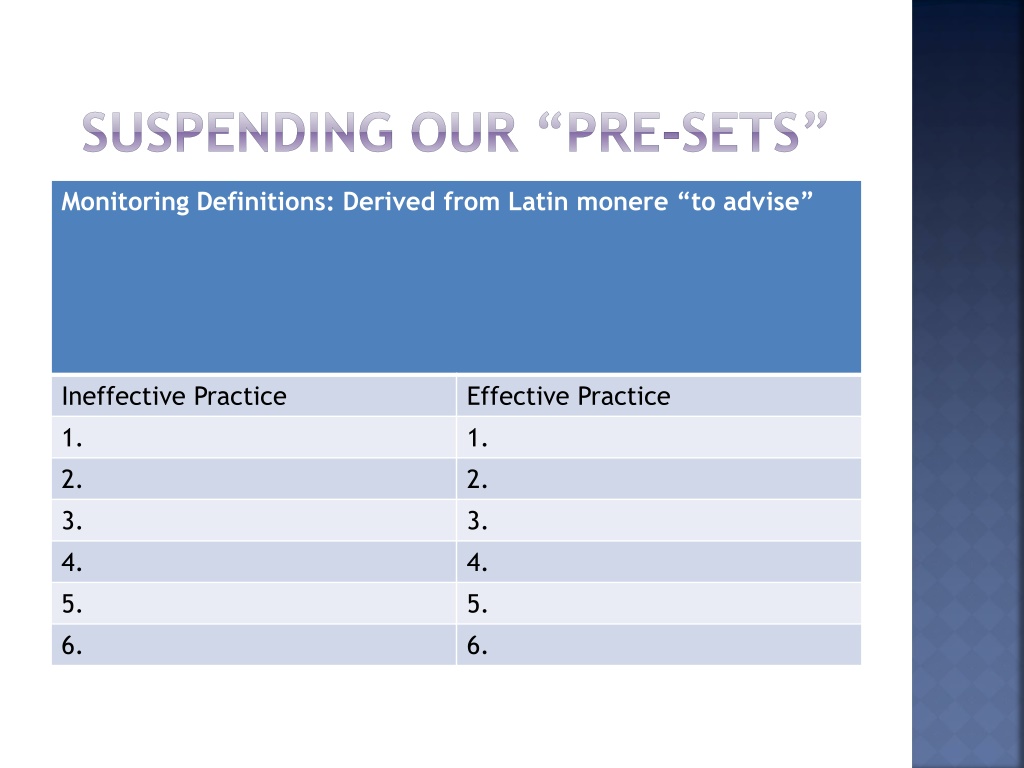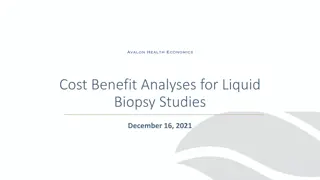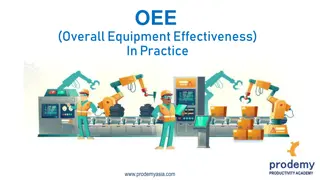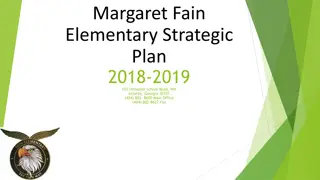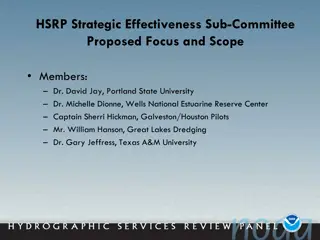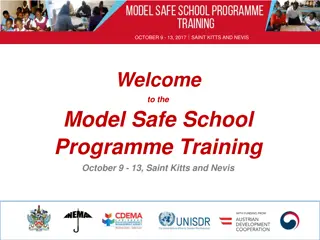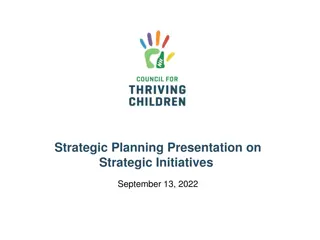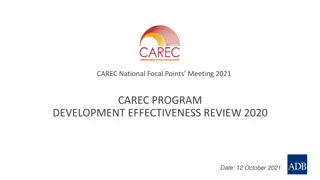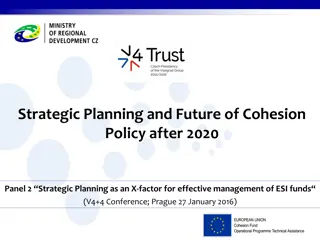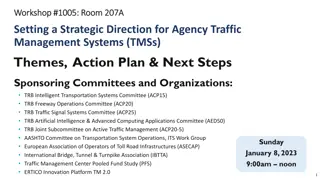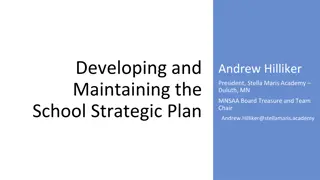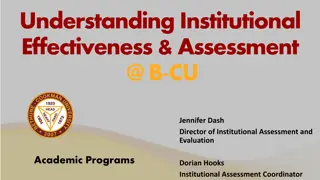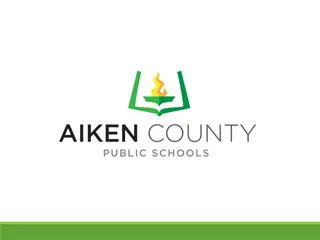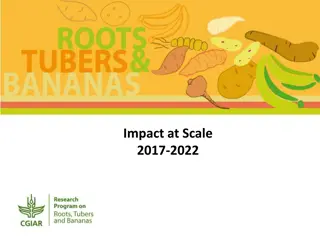Enhancing School Effectiveness Through Strategic Practices
Explore the shift in school improvement practices, emphasizing effective schools research and the importance of continual improvement. Dive into the conceptual framework of schools as units of change, focusing on improved student performance and clear reporting systems. Learn about the accreditation process and the 80/20 principle shaping school assessments in West Virginia.
- School improvement
- Effective schools research
- Accreditation process
- Student performance
- Continuous improvement
Download Presentation

Please find below an Image/Link to download the presentation.
The content on the website is provided AS IS for your information and personal use only. It may not be sold, licensed, or shared on other websites without obtaining consent from the author. Download presentation by click this link. If you encounter any issues during the download, it is possible that the publisher has removed the file from their server.
E N D
Presentation Transcript
SUSPENDING OUR PRE-SETS Monitoring Definitions: Derived from Latin monere to advise Ineffective Practice 1. 2. 3. 4. 5. 6. Effective Practice 1. 2. 3. 4. 5. 6.
EFFECTIVE SCHOOLS RESEARCH Effective Schools Research emerged in the late 60s in response to the Coleman Report Correlates of Effective Schools Continuous Improvement and Systems Thinking West Virginia Standards for High Quality Schools
CONCEPTUAL FRAMEWORK SCHOOL AS THE UNIT OF CHANGE IMPROVED STUDENT PERFORMANCE CLEAR PUBLIC REPORTING SYSTEM SCHOOL IMPROVEMENT PROCESS ACCREDITATION PROCESS
UNIT OF CHANGE Every School Improving Improvement from Inside Context Function Form Process
SCHOOL PROCESS Learning Organization CHARTING A COURSE What evidence will you accept? What do you want your school to look like in a year? Three? Five? Consistent Pervasive Practice Understand Current Conditions Plan Implement Refine Data Self-study
IMPROVE STUDENT PERFORMANCE A F Grade Card Ensure grade reliability State Awards Public Announcement
ACCREDITATION 1. School Self-Study 2.Submit SMR with self-rating and evidence 5. School uses Team Feedback for Improvement REVIEW PROCESS 4. Team visits school, reviews evidence, provides ratings & recommendations 3. Review team studies SMR
SCHOOL IMPROVEMENT 10 STEPS Understanding WV HQS for School Improvement Understanding Continual Improvement and Systems Thinking Evaluating Progress Clarifying Vision, Mission and Core Beliefs Developing the Work Plan Writing Action Steps Data Analysis Choosing Research-based Strategies Setting Priorities Establishing Goals and Objectives
80/20 PRINCIPLE The 80/20 Principle represents a major shift in how school improvement in West Virginia will be assessed and reported. Accreditation in the state will now be based equally on verification of a school s claims made in the School Monitoring Report: Use of Continuous Improvement Processes to successfully meet the Standards for High Quality Schools; Plan to improve based on a needs analysis of resources, facilities, and efficiency needs Professional Development and Capacity Building Needs Best Practices extant in the school; and Code and policy compliance
STANDARDS AND FUNCTIONS FOR HIGH QUALITY SCHOOLS KNOW THE STANDARDS AND FUNCTIONS Activity: Matching evidence to standards and functions Each table will need: Reader (cards) Recorder (paper) Copies of the WV Standards for HQS
DEBRIEF Evidence Of Practices And Processes Standards and Functions
UNDERSTANDING THE OEPA MONITORING PROCESS Who? When? Why? What? Where? How?
UNDERSTANDING THE OEPA MONITORING PROCESS Who? Team Leader and all team members (size depends on school) What? A process that assures the evidence examined by every member is heard and considered by the team in reaching agreement on a rating for each function.
Verifying and Gathering Evidence HOW? Team members will spend one day collecting and reviewing evidence through observations and interviews. Using that information, they will verify the evidence you submitted for each standard on the School Monitoring Report and identify any additional evidence they find that supports or negates the presence of the standards and functions. They will come to consensus on the rating for each function and provide recommendations if appropriate.
UNDERSTANDING THE OEPA MONITORING PROCESS When? The Team Consensus Meeting will begin as soon as the last observation or interview has been completed. Where? The meeting will take place at the school in the workroom provided.
UNDERSTANDING THE OEPA MONITORING PROCESS Why? To provide the school with feedback that gives a clear picture of current conditions and allows the school to build on those conditions to improve student performance.
Verify Evidence Provided by the School in the School Monitoring Report
THE TEAM CONSENSUS MEETING HOW? The Lead member on Standard 1 will begin the consensus discussion. He or She will: Identify the evidence submitted by the school and the verifying evidence that she has found. Add evidence that either supports or negates the school s evidence. Ask team members to contribute additional evidence (if any). Poll the team regarding their rating of that function.
UNDERSTANDING THE PROCESS Simulating Individual and Team Processes for OEPA School Monitoring
UNDERSTANDING THE OEPA MONITORING PROCESS Overview Each Table will assume the role of a monitoring team. Review the school report. Review the substantiating evidence collected by the team. Come to consensus on the rating for each function. 1. a) b) c)
Team Notes Color Coded by Person and standard
UNDERSTANDING THE OEPA MONITORING PROCESS How? 1. The lead will review each piece of school evidence submitted for the standard & functions assigned. Then identify substantiating evidence he/she found to verify or negate that school s evidence including other evidence the school didn t list.
UNDERSTANDING THE OEPA MONITORING PROCESS Conducting the Consensus Meeting 2. The lead member will begin the discussion by reviewing his/her assigned standard, and function (one at a time). 3. Identify the key words within the function statement. (Function A only for training purposes)
UNDERSTANDING THE OEPA MONITORING PROCESS Conducting the Consensus Meeting The lead for that standard calls upon team members to provide any additional information they found that validates or negates the school s evidence for that function. (Put everything on the table) 4.
REACHING TEAM CONSENSUS How? 5. Review the Rating Scale. Share the school s self- rating and then poll the team to reach consensus on the function at hand.
RATING SCALE 4 = Strong and pervasive characteristic (Distinguished) (All aspects of the function are present at the school and are applied to all appropriate aspects of school/classroom operations and behaviors) 3 = Present but not a pervasive characteristic (Accomplished) (Most aspects of the function are present at the school; aspects are broadly applied but may not be consistently and pervasively demonstrated throughout all applicable school/classroom operations and behaviors.) 2 = Present in a few areas and/or situations but needs improvement (Emerging) (Some aspects of the function are present at the school; aspects are occasionally demonstrated in applicable school/classroom operations and behaviors.) 1 = Rarely evidenced; needs significant improvement (Unsatisfactory) (Few, if any, aspects of the function are present at the school; aspects are rarely demonstrated in applicable school/classroom operations and behaviors.)
DEBRIEF Questions? Issues? Comments?
